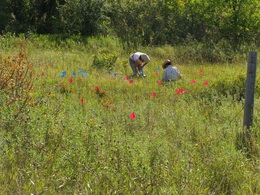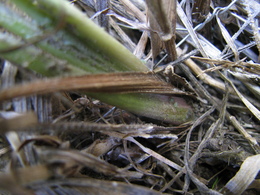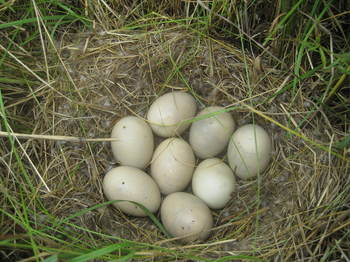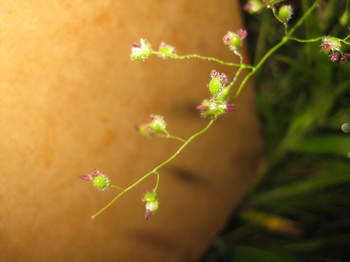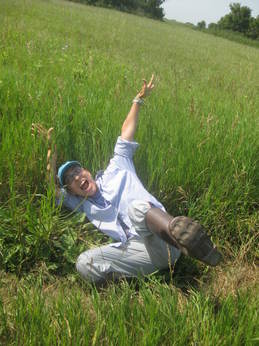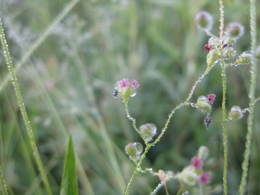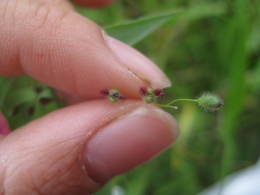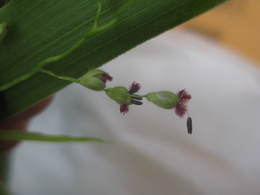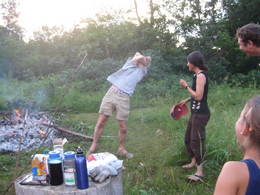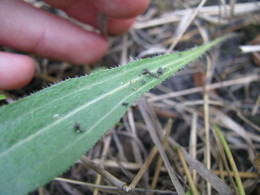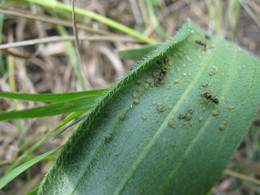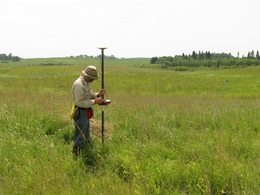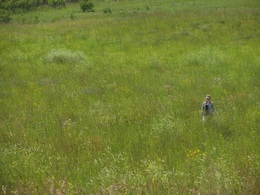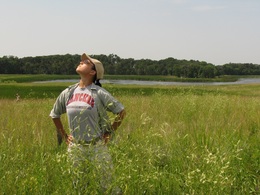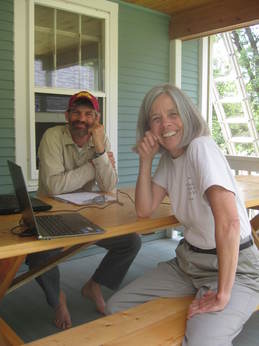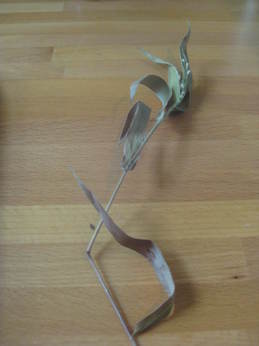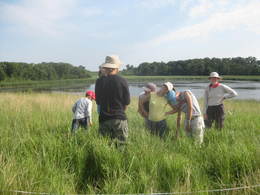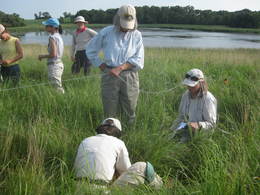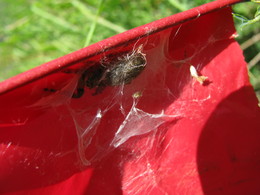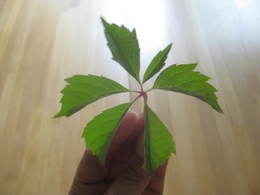|
|
The past couple of days have been lovely for outdoor work–sunny, cool, a little breezy. On Monday we said bon voyage to the Wagenius family as they prepared for their trip back to Chicagoland. Stuart will be back next week, but Gretel and the kids are done for the summer. Now there are five of us and no shortage of work to do.
Monday morning we went to the site off of hwy 27 to take demography data on plants that flowered last year and reconcile errors from this year’s demography census. With two teams working with the GRS-1 GPS units, the task went quickly and smoothly.
We spent Monday afternoon re-finding seedlings at KJ’s. This is a particularly challenging site because there is a high density of plants in a small area. We continued the endeavor this morning, and I’m happy to say are nearly finished. We should be able to defeat the beast tomorrow morning.
Here are Jill and Maria looking for seedlings at KJ’s. Red flags mark completed focal plants.

This afternoon we performed some routine maintenance of the main experimental plot, pulling out flags that marked plant we could not find. Then we spent the rest of the afternoon on individual projects.
Karen Taira, who came up last week, has been spending her days working on her pollination experiment involving several species of Helianthus. Her field story of the day was that she found a pile of entrails next to one of her experimental plants. Apparently they were bigger than a prairie dog’s and smaller than a human’s. Perhaps it’s a new form of sacrificial sun worship–Praise Helianthus!
Like their hosts, Echinacea aphids exhibit a strong seasonality. There’s a sharp rise in the frequency and abundance of aphid infestation followed by a rapid decline in early fall. That decline has occurred much earlier this year than last year. Fortunately, that has given me a chance to make some observations about what happens to aphids at the end of the summer. Here are a few things I’ve noticed:
1. Throughout my surveys in CG1 and several prairie remnants, I’ve noticed that the frequency of winged morphs has declined since July. Last week, I did not see any winged aphids, with the exception of a couple at East Elk Lake Road. This implies that dispersal declines as aphid numbers drop.
2. I and several others have noticed that aphids are starting to congregate at the base of the plant both at the petioles and at the base of the stem. I’ve also seen aphids crawling down beneath the soil surface and a few latched onto the tops of roots. One possibility is that as plants withdraw resources from their leaves, aphids move down the plant to follow their food source. I’ve also seen ants moving aphids at the base of the plant and placing them in dirt structures. These observations support the notion that aphids overwinter on Echinacea roots.
Many aphid species in temperate regions spend the winter and summer on different plants. Their winter host is where they lay eggs and their summer host is where they feed and reproduce asexually. My guess is that Aphis echinaceae does not have a separate winter host.
This plant at Nessman’s had a bunch of aphids congregated at the base. Notice the little green guys on the stem:

This is one of the plants from my aphid addition/exclusion experiment in CG1. There are still aphids on the leaves, but most of them have moved to the petioles:

Today was a cool day! High temp of mid 70s.
Ruth and Amy came up from the Twin Cities, to give us a jumpstart to Seedling Refinds.
We overcame some technical hurdles with DroppedBoxx on Sulu and Chekov (our two lovely GPS units), and started seedling refinds at Steven’s Approach in the morning, worked way past lunch hour before Stuart called timeout.
We had lunch supplemented generously with bounty from the Wagenius family garden – juicy chestnut crabapples, ripe sweet cantaloupe, and cool yellow watermelon!
After lunch we stopped by the road outside CG2/Jennifer’s Plot at Hegg Lake, and harvested Bouteloua. We will broadcast the Bouteloua seeds in CG2 after the burn if DNR decides to burn the plot; otherwise we will broadcast half the seeds in the fall and half in spring.
Then we resumed seedling refinds at Steven’s Approach. We solved some tricky mysteries with the seedling maps, and completed Steven’s Approach! We also found a couple of flowering plants that had been missed during demo.
While we were doing all that, Karen was working hard at her independent project. The searching and keying paid off as she found a third species of Helianthus, H. tuberosus, at Hegg Lake.
Here’s an unrelated picture of a pheasant’s nest near my Dichanthelium plot. The pheasant mum and I often startled each other during those mornings when I did fieldwork.

Look, a pheasant egg!

And I know you’ll forgive me for posting yet another picture of Dichanthelium 😀

Hi all, Maria at K-town.
It was raining this morning as we bade goodbye to Lydia. All the best to Lydia as she prepares to go to Ireland for study abroad! Here’s a great picture to remember the fun times in the prairie 😀

Karen arrived at the town hall yesterday evening! This morning, she braved the rain and went out to many prairie remnants to look for Helianthus. She reports that Riley, Staffanson and Hegg Lake seem to hold the best promise for her pollen limitation experiments with H. maximiliani and H. pauciflorus, and maybe another H. species, if she can find it.
Andrew arrived back from his weekend trip announcing that he had all the food that’s bad for you all in one day. He, Shona, and Jill went to watch Alladin, the play by the Prairie Fire Children’s Theatre that Per and Hattie were in. They enjoyed it very much!
The skies gradually cleared up though temps were still in 60s-70s. It was quite chilly in the town hall.
With the squash, zucchini, and cucumber explosion 😀 😀 :D, Shona made zucchini bread. We also welcomed Kelly’s return from Northbrook about an hour ago.
Lastly, here’s a beautiful photo of Dichanthelium with morning dew:

Howdy folks,
Maria reporting from K-town.
Sunday we had a real day off =)
The weather was good and sunny, but not too hot.
Random tidbits from the town hall:
Shona made oatmeal pancakes for breakfast – they were really yummy – thanks Shona!
Kelly and Shona went swimming at Elk Lake and bumped into the Wagenius family
Katherine found a new trail in the forest at the Runestone Park on her biking adventure
Andrew had a great time at home and arrived at the town hall before 11pm
Lydia spent the day helping out in the kitchen at the camp in Alexandria
I made Irish Soda Bread to use up some sour milk, but still have ~1 cup sour milk (turned into buttermilk substitute, any ideas what to do with it? Pancakes would be easiest, but we just had them)
After the weekend break, it’s time for work again! Monday (today) we divided and conquered.
AM – Greg set out his yellow pan traps in his remnants. Stuart, Katherine, Jill, Lydia and I did demo in the remnants. Ruth and Greg came to join us. We found many Echinacea flowering at Loeffler’s Corner East, an okay number at Loeffler’s Corner West, 2 at Railroad Crossing (Douglas County), and ~6 at Yellow Orchid Hill.
The others (Shona, Kelly, Andrew) did CG1 rechecks and then worked on their independent projects.
Ruth bought some delicious fluffy spongy chocolate cake which we cleaned off the dish.
PM – The two teams switched jobs. Stuart led Shona, Kelly, Andrew, Ruth and Greg in demo at KJs and On 27. The rest of us did CG1 rechecks, and then worked on independent projects.
Here’s a file called “Crash Course in R”, which might be helpful to folks
crashR.2.pdf
Now for some photos!
Flowering Dichanthelium!

I think this is a super cool picture as it shows 3 stages of Dichanthelium stigmas/anthers emergence. See how the bottom-most spikelet has the stigma just emerging, while the anthers are still inside; the middle spikelet is open and has both stigma and anthers well-exserted; and the top spikelet is closed and the anthers are drooping out from the spikelet.

Last but not least here’s an epic picture from our bonfire last year 😀

Saturday brought a resurgence of the “not-so-bad” weather we’ve been enjoying this week. Several rainstorms have brought some much needed moisture to the soil. The reason I mention this is that while I worked on my aphid addition/exclusion experiment, I noticed a lot of dirt mounds on plants where aphids were present. Presumably, ants build these structures to cultivate aphids. Some of these were small, consisting of only a few small pieces, and some were large, taking up a large portion of a leaf. Here’s one of the smaller examples. The opposite side of the leaf was covered in aphids.

Here’s a picture of one of the plants in my aphid addition group. As you can see, the ants are taking full advantage of the situation:

As for other field work, Kelly spent the morning checking the status of flowers for her phenology study. Most of the remnants have stopped flowering, with the exception of one plant at a small remnant and many at the Staffanson prairie preserve. Because the west half of Staffanson was burned in May, Echinacea began blooming later than in the unburned half.
In the evening, we all gathered at the Wagenius family home for potluck dinner and bonfire. I should say bonfires, since there were two right next to each other. Pyromanic desires were fulfilled by all.
Monday was quite sultry, if I remember correctly. In the morning we divided forces to look at flowering phenology in C1 and to finish measuring the plants in Amy Dykstra’s experiment at Hegg Lake. She has two experimental plots there: one containing the offspring of inter-remnant crosses and the other containing seeds collected from source populations between Minnesota and South Dakota. She sowed seeds in 2008 and has been tracking their progress every year since. Once we finished finding and measuring plants, Stuart took GPS points for each experimental plot:

While he was doing that, Shona trekked off into the prairie to check on the plants in her hybridization experiment.

Meanwhile, Lydia and I waited by the truck and took advantage of the opportunity for an epic pose. I’d say it was successfully epic.

Friday the 13th of July! Sorry for the late posting.
Weather report:
According to my field notes, at 6.35am at Hegg Lake it was warm, no breeze, and a little dewy. The rest of the day, it was hot and humid, though not as bad as the past few days.
Fieldwork report (morning):
I was at Hegg Lake from 6.35am-10.30am, checking on my Dichanthelium plants for seeds that are ready to be harvested. The unfortunate news: 1 of my experimental culms dried out, and another culm was broken off 🙁 On the brighter side, the potted Dichanthelium from my pilot bulk experiment are doing quite well, and a second one started producing spikelets!
Kelly and Shona were out at Staffanson GPSing all the flowering Echinacea plants, including Kelly’s phenology plants.
Andrew and Lydia were in C1 observing and catching pollinators for Andrew’s project. Lydia caught one pollinator. There wasn’t much activity in the garden.
Jill was identifiying ants under the dissecting scope in the basement all morning. She found that many of them were Lasius and Formica.
Katherine was working with the data from the aphid survey and conducting preliminary analyses. She is planning on performing aster analysis with her data.
Ruth, Amy and Brad came over today. After lunch, we headed out to Hegg Lake to Amy’s plots where we measured seedlings that were sowed in 2008. We were out there until almost 6pm, impressive work!

Stuart and Ruth 🙂

Poor broken culm of Dichanthelium. See how some spikelets were still open?

Tired Team Echinacea…

After last week’s sultry weather, we’ve been enjoying a “dry heat”, as Greg Diersen so artfully put it. This morning everyone went their separate ways to pursue their individual projects:
Shona, Maria, and Lydia went directly to Hegg Lake and combined forces to measure plants and take GPS points. Shona also photographed Echinacea pallida and E. angustifolia plants as part of her project to assess species traits.
Andrew searched the main experimental plot (C1) for plants where he can observe pollinators. Because peak flowering has passed, his selection of flowering heads is growing slimmer by the day. Fortunately, he has some good observations under his belt and will be able to collect more before plants stop flowering.
Jill and Greg joined forces in operation pit-fall trap. Greg’s traps are bowls full of soapy water that he sets on the ground and leaves out for a couple of days. Jill’s are tubes full of propylene glycol that she submerges in the soil and leaves out for a week. Today, they set out Greg’s traps and collected from Jill’s. I have to say: the smell of dead insects stewing in propylene glycol for a week is probably one of the worst smells I have experienced.
I spent the morning removing aphids from plants in my aphid addition/exclusion experiment. Even though it has been three days since my last exclusion, there were aphids on 11 out of 50 plants in my exclusion group. One plant had 67 aphids–all in three days! Those aphids are moving and breeding fast.
This afternoon we joined together in our common goal of measuring every plant in C1. My mother used to say that the only way to eat an elephant is one bite at a time. Well, today we bit a big chunk off of our elephant, finishing up the sections planted in 1997, 1998, and 1999. We have less than half an elephant to go!
And now for a picture. In addition to helping us keep track of plants, pin flags make great habitat for spiders:

(Aghh I just finished writing and then when i tried to publish the site told me that my session had expired and of course I lost the whole blog post T___T )
Anyways…
Today was a very hot and humid day. Temperatures into the 90s, feeling like 100. Sweaty sweaty sweaty.
Some of us accomplished field work.
Andrew was in C1 this morning painting bracts and bagging Ech flowers.
Katherine was also in C1 doing her aphid add/exclude experiment.
Shona was out at Hegg Lake for 4 hours painting bracts and observing crossed styles.
I (Maria) was also at Hegg Lake (for my own reference from around 10.30 – 4.40pm) surveying Dichanthelium inflorescences I’ve been tracking for the past week or so, and more importantly, finding plants for my pollen limitation experiment. I have 31 plants flagged and 62 inflorescences twist-tied. I’ll be initiating the experiment tomorrow, so I should be in bed now (hence, I’ll give more details in a later post).
To end off the week, here’s a special 6-leaved Virginia Creeper (they are usually 5-leaved) I found in the 99 south garden. Hope it brings everyone good luck!

|
|
